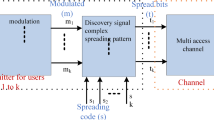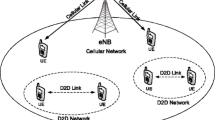Abstract
To initiate Device to Device (D2D) communication, proximal device discovery is the most important problem in the contemporary cellular networks. By using reference signal (RS), devices can be discovered for a D2D companion through the proximal discovery process. We propose an RS model for proximal device discovery and discovery resources multiplexing using Zadoff–Chu (ZC) sequence for RS transmission and detection. The proposed proximal device discovery model is robust for collision avoidance, and provides rapid and accurate discovery in a dense area. The performance of proposed discovery procedure is verified numerically and by simulation. Random search and the smart random search algorithms are applied for evaluation of proposed model in terms of discovery time and discovered devices.








Similar content being viewed by others
References
Fodor, G., et al. (2016). An overview of device-to-device communications technology components in METIS. IEEE Access, 4, 3288–3299.
Yaacoub, E., et al. (2015). On the impact of D2D traffic offloading on energy efficiency in green LTE-A HetNets. Wireless Communications and Mobile Computing, 15(6), 1089–1105.
Alam, M., et al. (2014). Secure device-to-device communication in LTE-A. IEEE Communications Magazine, 52(4), 66–73.
Hayat, O., Ngah, R., & Zahedi, Y. (2019). In-band device to device (D2D) communication and device discovery: A survey. Wireless Personal Communications, 106(2), 451–472.
Madhusudhan, S., Jatadhar, P., & Reddy, P. D. K. (2016). Performance evaluation of network-assisted device discovery for LTE-based device to device communication system. Journal of Network Communications and Emerging Technologies (JNCET), 6(8), www.jncet.org.
Zhang, A., Wang, L., & Zhou, L. (2016). Location-based distributed caching for device-to-device communications underlaying cellular networks. Wireless Communications and Mobile Computing, 16(13), 1859–1875.
Jung, S., & Chang, S. (2014) A discovery scheme for device-to-device communications in synchronous distributed networks. In 16th international conference on advanced communication technology. IEEE.
Hayat, O., Ngah, R., & Zahedi, Y. (2017). Cooperative device-to-device discovery model for multiuser and OFDMA network base neighbour discovery in in-band 5G cellular networks. Wireless Personal Communications, 97(3), 4681–4695 (in English).
Tang, H., Ding, Z., & Levy, B. C. (2014). Enabling D2D communications through neighbor discovery in LTE cellular networks. IEEE Transactions on Signal Processing, 62(19), 5157–5170.
Zhu, F., & Wei, J. F. (2017). Localization algorithm for large scale wireless sensor networks based on fast-SVM. Wireless Personal Communications, 95(3), 1859–1875 (in English).
Lin, Z., Du, L., Gao, Z., Huang, L., & Du, X. (2016). Efficient device-to-device discovery and access procedure for 5G cellular network. Wireless Communications and Mobile Computing, 16(10), 1282–1289.
Lin, X., et al. (2014). An overview of 3GPP device-to-device proximity services. IEEE Communications Magazine, 52(4), 40–48.
Fodor, G., et al. (2012). Design aspects of network assisted device-to-device communications. IEEE Communications Magazine, 50(3), 170–177.
Hayat, O., Ngah, R., & Zahedi, Y. (2018). Device discovery for D2D communication in in-band cellular networks using sphere decoder like (SDL) algorithm. Eurasip Journal on Wireless Communications and Networking, 2018(1), 74 (in English).
Sarret, M. G., et al. (2016) Providing fast discovery in D2D communication with full duplex technology. In International workshop on multiple access communications. Springer.
Lien, S.-Y., et al. (2016). 3GPP device-to-device communications for BeyonD 4G cellular networks. IEEE Communications Magazine, 54(3), 29–35.
Hong, J., Park, S. & Choi, S. (2014) Neighbor device-assisted beacon collision detection scheme for D2D discovery. In 2014 International conference on information and communication technology convergence (ICTC). IEEE.
#74, G.T.-R.W., Techniques for D2D Discovery. Qualcomm Incorporated, August, 2013. R1-133600.
Park, S., & Choi, S. (2014) Expediting D2D discovery by using temporary discovery resource. In 2014 IEEE global communications conference. IEEE.
You, L., et al. (2011) ALOHA-like neighbor discovery in low-duty-cycle wireless sensor networks. In 2011 IEEE wireless communications and networking conference. IEEE.
Sun, G., et al. (2012) PHED: Pre-handshaking neighbor discovery protocols in full duplex wireless ad hoc networks. In Global communications conference (GLOBECOM), 2012 IEEE. IEEE.
Xenakis, D., et al. (2015). Distance distributions and proximity estimation given knowledge of the heterogeneous network layout. IEEE Transactions on Wireless Communications, 14(10), 5498–5512.
Burghal, D., Tehrani, A. S., & Molisch, A. F. Directional neighbor discovery in dual-band systems. In 2015 49th Asilomar conference on signals, systems and computers. IEEE.
Bertrand, P. (2011) Channel gain estimation from sounding reference signal in LTE. In Vehicular technology conference (VTC Spring), 2011 IEEE 73rd. IEEE.
Poor, H.V., An introduction to signal detection and estimation. 2013: Springer Science & Business Media.
Ölcer, G. M. (2010). Future home networks: Connectivity in 60 GHz Home Networks. http://resolver.tudelft.nl/uuid:db28b919-a01b-48d3-9c4b-7f05b9a14d72. Accessed 20 Mar 2017.
Ölçer, G. M., Genç, Z., & Onur, E. (2010). Smart neighbor scanning with directional antennas in 60 GHz indoor networks. In 21st annual IEEE International Symposium on Personal, Indoor and Mobile Radio Communications, Instanbul, Turkey (pp. 2393–2398).
Ölçer, G. M., Genç, Z., & Onur, E. (2010) Smart neighbor scanning with directional antennas in 60 GHz indoor networks. In 21st annual IEEE international symposium on personal, indoor and mobile radio communications. IEEE.
Lee, W., Kim, J., & Choi, S. W. (2016). New D2D peer discovery scheme based on spatial correlation of wireless channel. IEEE Transactions Vehicular Technology, 65(12), 10120–10125.
Acknowledgements
The authors would like to express their gratitude to Ministry of Higher Education (MOHE) in Malaysia and Universiti Teknologi Malaysia (UTM) for providing the financial support for this research through the Fundamental Research Grant Scheme (FRGS) (R. J130000.7823.4F965). The Grant is managed by Research Management Centre (RMC) at UTM.
Author information
Authors and Affiliations
Corresponding author
Additional information
Publisher's Note
Springer Nature remains neutral with regard to jurisdictional claims in published maps and institutional affiliations.
Rights and permissions
About this article
Cite this article
Hayat, O., Ngah, R. & Zahedi, Y. Device Discovery Signal Design for Proximal Devices in D2D Communication. Wireless Pers Commun 108, 865–878 (2019). https://doi.org/10.1007/s11277-019-06435-6
Published:
Issue Date:
DOI: https://doi.org/10.1007/s11277-019-06435-6




